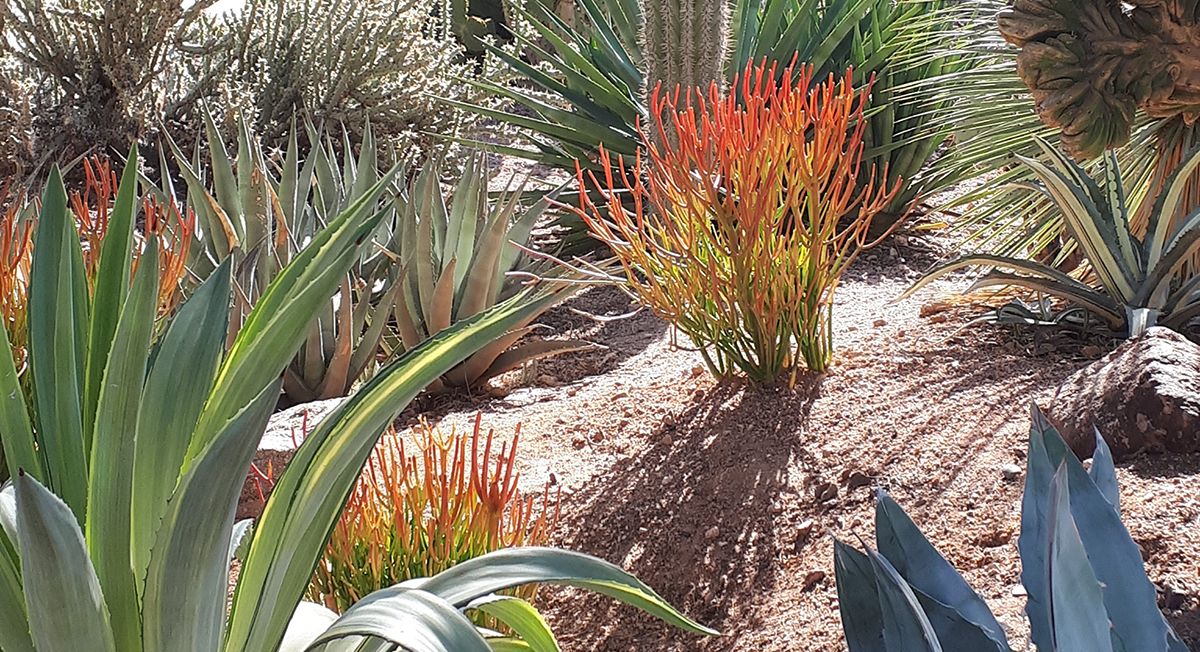
In the Garden
By Claire McCaughey
A snowbird’s guide to desert plants of Arizona
I have been visiting Arizona in the winter with my husband, Jim, for 10 years. Like many snowbirds, we love the escape to the sunny, dry, warm climate. One of the biggest attractions of the Southwest is the desert landscape and within it, the surprising variety of plants that manage to survive with very little precipitation (less than 250 mm a year of rainfall is the definition of a desert). We regularly hike and spend lots of time outdoors. Hiking affords the opportunity to see the plants in nature in the Sonoran Desert, while visits to the Desert Botanical Garden in Phoenix or the Sonoran Desert Museum in Tucson provide a chance to see native Arizona plants as well as desert plants from other regions of the world.
Shapes, shadows and colours in the desert
There are many reasons why desert plants are interesting — beyond the fact that they survive with almost no water. Most striking is the architectural form of plants such as the century plant (Agave americana), the saguaro cactus (Carnegiea gigantea) and the velvet mesquite tree (Prosopis velutina). These plants create beautiful shadows in the uncluttered desert landscape. They often grow quite large and have an imposing presence.
Desert plants have adapted to the meagre amount of rain. Their seeds lie dormant in the ground, until there is sufficient moisture for them to germinate and grow. It is indeed quite thrilling to see the desert in bloom — where before there was a grey-brown landscape. The blooming of the desert usually occurs from mid-March to early April, and the extent of bloom varies from year to year, depending on the amount of rain the previous winter. During the blooming period, the landscape is almost overnight filled with yellow, red, orange, blue and purple as Mexican poppies (Eschscholtzia californica ssp. mexicana), desert bluebells (Phacelia campanularia), desert lupines (Lupinus arizonicus), chuparrosa (Justicia californica) and other flowering plants are visible in large patches.
Quintessential plants of the Sonoran Desert
The plant that most people associate with Sonoran Desert is the saguaro cactus (Carnegiea gigantea). These giant cacti with huge arms can grow to 12 metres tall and survive more than 200 years. Blue paloverde (Parkinsonia florida) is an unusual tree because of the colour of its bark being a vivid green or sometimes bluish green. It blooms in late March or early April with vivid yellow flowers. Mesquite trees such as velvet mesquite (Prosopis velutina) have beautiful sculptural branches and are harvested for specialized wood products.
Creosote bush (Larrea tridentata) is found almost everywhere in the desert (note: the creosote in the name is not at all related to petroleum products). To look at, it is a rather nondescript shrub. Its attraction is evident after rain in the desert, as it gives off a distinctive fresh smell and many people from the southwest say that the desert smells like creosote bush. Creosote bush also yields an oil which is used in ointments by indigenous peoples for skin conditions. Its other claim to fame is its longevity. Many creosote bushes have enormous root systems which spawn new plants far away from the mother plant. Another plant which is very reminiscent of the southwest is pinyon pine (Pinus edulis), which when burning in a firepit has a familiar aromatic smell.
Edibles in the desert?
As well as cultivated plants there are also edible native plants in the desert. Indigenous peoples of the southwest such as the Tohono O’odham people (and the earlier Hohokam people) have survived on these plants for millennia. The velvet mesquite tree has seed pods which yield a flour for baking. This has a mild sweet flavour with a hint of spice somewhat reminiscent of gingerbread. The roots of agave can be roasted as a starchy vegetable. Prickly pear cactus (Opuntia ficusindica) is used in a variety of ways. The colourful red fruit can be used for jams and Fifty-Five Plus Magazine – Ottawa Section 31 January/February 2020
jellies or dried for tea (iced prickly pear tea is served at the Desert Botanical Garden). The “pads” of the prickly pear can be grilled on the barbeque (once the prickly parts are removed) and are often referred to as nopales or nopalitos. One of the most interesting cultivated plants in the desert is the tepary bean (Phaseolus acutifolius). This incredible bean can be grown with only one or two irrigations. The bean can be used as almost any other dried bean in soups, stews or even as hummus. The Heard Museum of American Indian Art in Phoenix serves a most delicious tepary bean hummus for lunch.
Claire McCaughey practises and teaches Ikebana (the art of Japanese floral design). She has a certificate in Sustainable Urban Horticulture from the University of Guelph and volunteers with Master Gardeners of Ottawa Carleton.






